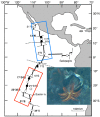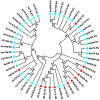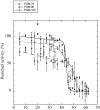Balanced Polymorphism at the Pgm-1 Locus of the Pompeii Worm Alvinella pompejana and Its Variant Adaptability Is Only Governed by Two QE Mutations at Linked Sites
- PMID: 35205251
- PMCID: PMC8872362
- DOI: 10.3390/genes13020206
Balanced Polymorphism at the Pgm-1 Locus of the Pompeii Worm Alvinella pompejana and Its Variant Adaptability Is Only Governed by Two QE Mutations at Linked Sites
Abstract
The polychaete Alvinella pompejana lives exclusively on the walls of deep-sea hydrothermal chimneys along the East Pacific Rise (EPR), and displays specific adaptations to withstand the high temperatures and hypoxia associated with this highly variable habitat. Previous studies have revealed the existence of a balanced polymorphism on the enzyme phosphoglucomutase associated with thermal variations, where allozymes 90 and 100 exhibit different optimal activities and thermostabilities. Exploration of the mutational landscape of phosphoglucomutase 1 revealed the maintenance of four highly divergent allelic lineages encoding the three most frequent electromorphs over the geographic range of A. pompejana. This polymorphism is only governed by two linked amino acid replacements, located in exon 3 (E155Q and E190Q). A two-niche model of selection, including 'cold' and 'hot' conditions, represents the most likely scenario for the long-term persistence of these isoforms. Using directed mutagenesis and the expression of the three recombinant variants allowed us to test the additive effect of these two mutations on the biochemical properties of this enzyme. Our results are coherent with those previously obtained from native proteins, and reveal a thermodynamic trade-off between protein thermostability and catalysis, which is likely to have maintained these functional phenotypes prior to the geographic separation of populations across the Equator about 1.2 million years ago.
Keywords: Alvinellidae; adaptive mutations; balancing selection; gene; phosphoglucomutase; thermal stability.
Conflict of interest statement
The authors declare no conflict of interest.
Figures






Similar articles
-
Thermal selection of PGM allozymes in newly founded populations of the thermotolerant vent polychaete Alvinella pompejana.Proc Biol Sci. 2004 Nov 22;271(1555):2351-9. doi: 10.1098/rspb.2004.2852. Proc Biol Sci. 2004. PMID: 15556887 Free PMC article.
-
Detection and characterisation of mutations responsible for allele-specific protein thermostabilities at the Mn-superoxide dismutase gene in the deep-sea hydrothermal vent polychaete Alvinella pompejana.J Mol Evol. 2013 May;76(5):295-310. doi: 10.1007/s00239-013-9559-y. Epub 2013 Apr 23. J Mol Evol. 2013. PMID: 23608997
-
Determining gene flow and the influence of selection across the equatorial barrier of the East Pacific Rise in the tube-dwelling polychaete Alvinella pompejana.BMC Evol Biol. 2010 Jul 22;10:220. doi: 10.1186/1471-2148-10-220. BMC Evol Biol. 2010. PMID: 20663123 Free PMC article.
-
Genomic patterns of divergence in the early and late steps of speciation of the deep-sea vent thermophilic worms of the genus Alvinella.BMC Ecol Evol. 2022 Sep 3;22(1):106. doi: 10.1186/s12862-022-02057-y. BMC Ecol Evol. 2022. PMID: 36057769 Free PMC article.
-
Insights into metazoan evolution from Alvinella pompejana cDNAs.BMC Genomics. 2010 Nov 16;11:634. doi: 10.1186/1471-2164-11-634. BMC Genomics. 2010. PMID: 21080938 Free PMC article.
Cited by
-
Transcriptomics of the Anthopleura Sea Anemone Reveals Unique Adaptive Strategies to Shallow-Water Hydrothermal Vent.Ecol Evol. 2025 Apr 10;15(4):e71252. doi: 10.1002/ece3.71252. eCollection 2025 Apr. Ecol Evol. 2025. PMID: 40225888 Free PMC article.
References
-
- Holt R.D., Gaines M.S. Analysis of adaptation in heterogeneous landscapes: Implications for the evolution of fundamental niches. Evolut. Ecol. 1992;6:433–447. doi: 10.1007/BF02270702. - DOI
-
- Schmidt P.S., Serrão E.A., Pearson G.A., Riginos C., Rawson P.D., Hilbish T.J., Brawley S.H., Trussel G.C., Carrington E., Wethey D.S., et al. Ecological genetics in the North Atlantic: Environmental gradients and adaptation at specific loci. Ecology. 2008;89:91–107. doi: 10.1890/07-1162.1. - DOI - PubMed
-
- Nevo E., Lavie E., Ben-Shlomo R. Selection of allelic isozyme polymorphisms in marine organisms: Pattern, theory, and application. Isozymes. 1983;10:69–92. - PubMed
-
- Nevo E., Noy R., Lavie B., Beiles A., Muchtar S. Genetic diversity and resistance to marine pollution. Biol. J. Linn. Soc. 1986;29:39–144. doi: 10.1111/j.1095-8312.1986.tb01828.x. - DOI
Publication types
MeSH terms
Substances
LinkOut - more resources
Full Text Sources
Miscellaneous

